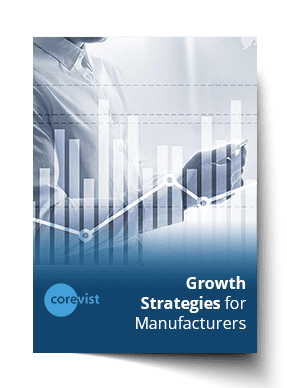Share
Author
George Anderson
Share
Originally published Oct 7, 2020. Refreshed and expanded Sep 22, 2021.
The digital revolution has disrupted every manufacturing vertical. How can manufacturers meet the new challenges of the digital age–and take advantage of new opportunities for growth?
If you have an SAP customer portal solution as part of your customer experience, you’re in a great place to grow. A digital portal brings you closer to your customers and gives you the control of customer experience that you need.
But not every manufacturer leverages their customer portal fully. Here are 5 growth strategies to help you get the most out of your portal.
1. Leverage your digital customer portal as a growth hub for your channel partners
The more your customre portal becomes a destination, the more your digital revenue will grow. So why not give your channel partners great reasons to come back to the portal?
Here’s one way to do this: Provide marketing materials which your channel partners can use to promote your products to end users. In coordination with your channel partners, you can craft campaigns around specific product lines—then offer the marketing materials in your web portal alongside your products.
This marketing content could take many forms:
- Customer testimonial videos: Who are your most passionate, innovative customers? They’re the best candidates to do promotional videos on your behalf.
- Industry award showcase: Have your products won awards or been named as leaders in industry analyst reports? These kinds of achievements make great cornerstones for campaigns. Create content to celebrate these milestones and pass it on to your dealers and distributors to promote to your end users.
- Product comparison infographic showing your product vs. the competition: Help your end users understand which niche your products fit into. Keep it positive and respectful and provide real value to your end users. (NOTE: If you’re working with channel partners on this campaign, a product comparison infographic only works if you leave out competing products which your distributor sells. Your distributor won’t want to undermine their existing relationships with your competitors.)
When you create this content on behalf of your channel partners, you leverage your digital customer portal as a “one-stop shop” for your channel partners to download your marketing materials (plus buy more product). This takes out friction in their marketing process and make it easy for them to promote your products.
NEW Report:
Growth Strategies for Manufacturers
Every manufacturer needs to grow in the digital age. Here’s the ultimate guide to growth strategies for manufacturers. Read now.
2. Leverage cross-sell/upsell capabilities in your web store
If your digital customer experience includes B2B eCommerce, cross-selling/upselling is a great way to grow your AOV (average order value).
Here are some ideas:
- Cross-sell your own related products. Do you offer parts, consumables, or ancillary products which are associated with a major product? You can sell more with cross-selling relationships in your B2B eCommerce catalog. The more value you can deliver in each transaction, the more your web store becomes a destination for buyers.
- Cross-sell 3rd party ancillary products. It might seem counterintuitive, but one way manufacturers can increase the value of their digital customer experience is to act like a distributor—selling 3rd party ancillary products that support their own major products. The more customer value you can deliver, the “stickier” your digital customer portal becomes, which leads to more repeat purchases and growing AOV (average order value).
- Upsell from base products to more specialized products. A B2B eCommerce solution with rich content allows you to educate your buyers in a self-guided experience. When you present an upsell from a base product to a more specialized product, the buyer has the opportunity to learn about the product in a no-pressure, self-service environment. This inspires confidence and empowers the buyer to choose the product most suited to their application—often the more specialized, upsold product.
3. Set up personalized catalogs and picklists in your web store
Want to make it easy for dealers & distributors to find the right products? Personalized catalogs and picklists offer a great solution. When you limit the products which are visible to any particular customer, you take out friction in the product search and ordering process. This creates a better customer experience, which leads customers to prefer buying from you over the competition.
Personalized catalogs/picklists offer a great solution for several use cases:
- Customers need to save on freight charges. If your buyers want to maximize their freight value by ordering from one plant only (and filling up the truck), personalized catalogs/picklists can help. When buyers choose products from one plant only (which is possible with personalized catalogs/picklists), they prevent waste in their freight charges. The key here is to drive personalization in real time from SAP, via deep integration.
- Customers don’t need access to your entire product catalog for their geography. For some customers and market segments, less is more. This is especially true in highly specialized scenarios. If your buyers need access to only a handful of SKUs, personal picklists can provide a relevant, filtered experience.
This is particularly easy in a solution like Corevist Commerce, which includes real-time SAP integration. If you already have product lists associated with particular distributors in SAP, Corevist Commerce can leverage those existing business rules to create a personalized experience in the web store. You don’t have to rebuild the business rules or maintain them in two places—only in SAP.
4. Develop thought leadership and content marketing to build your brand
Historically, manufacturers haven’t engaged in content marketing as much as other sectors have. Your value is in your product line and R&D, and your channel partners already understand your value.
That said, the digital revolution offers incredible opportunities to grow your mindshare through content marketing—both among channel partners, and among the end users of your products. Your end users need expert content to help them solve the larger problems which your products help solve. When you provide this content, it demonstrates thought leadership within your market and builds trust in your brand.
What does this look like in real life? Here are two examples.
Example 1: Construction equipment manufacturer selling durable equipment and parts through channel partners.
This manufacturer sells through dealers and distributors, who sell to the end users of equipment (construction contractors). There’s an opportunity here to provide expert content to contractors to help them understand the maintenance cycle for their equipment, how to choose the right machine for their application, best practices for specific types of construction projects, and so on.
If the manufacturer publishes thought leadership content along these lines, they can promote their content to dealers and distributors, who can promote it to the end user. This helps with brand building, and with a third party (dealer or distributor) endorsing your content, it will carry more authority.
Example 2: Chemical manufacturer selling adhesives to electronics manufacturers.
This manufacturer sells to other manufacturers. There’s an opportunity here to provide expert content to product leaders at electronics manufacturers. These leaders may need help understanding which adhesives are best suited to certain applications. Interactive content is especially powerful here—for example, a product comparison solution which allows users to input their requirements and get personalized, automated recommendations on which adhesives are best suited to their application.
5. Tailor your digital portal experience for different segments with reusable SAP integration architecture
For manufacturers selling in multiple geographies (and/or those with multiple brands), one digital portal experience rarely fits all. Different product lines, different SKU restrictions, different languages and currencies—all these things put complex demands on manufacturers when it comes to digital customer experience.
With a customer portal architecture that integrates with your SAP ERP system in real time, you can leverage SAP data for SKU permissions, currency, contract pricing, localized inventory availability, and more. (NOTE: Creating multiple storefronts on one SAP integration architecture is easy with Corevist solutions.)
This way, you bring tailored customer portal experiences to each geography and customer segment without recreating your SAP business rules in multiple systems. It’s a lean, agile, efficient way for global manufacturers to give their buyers the localized, personal experiences they need.
Want more?
Download our new report:
Growth Strategies for Manufacturers
We cover 18 growth strategies for manufacturers in the digital age. Read now.










